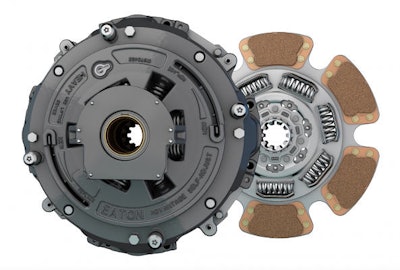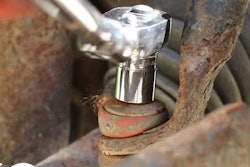
The aftermarket is full of parts options but when it comes to replacing a clutch damper it’s best to stay within the original specs.
Eaton Applications Engineer Mike Garrison says his company has noticed an over-spec trend from time to time that can lead to problems.
“Some people may think, ‘Well, a higher rating, or bigger might be better’ kind of thing. But we usually don’t recommend it because when you over spec the clutch from a torque standpoint you’re not getting as soft a rate as you could otherwise,” Garrison says. “In other words, it’s probably a stiffer spring to handle some artificial torque level that’s not there so your springs are actually stiffer then they need to be and probably stiffer than the original clutch which can actually change some of the original characteristics and not in a good way.”
Stiffer spring rates in a clutch damper mean more vibration, which can affect driver comfort and lead to durability or wear issues on various components. Softer spring rates help to better absorb engine vibrations that travel down the driveline during the combustion process.
While space restrictions have minimized noteworthy design changes in clutch dampers, materials have evolved allowing for softer spring rates and improved performance.
Driving habits have little impact on clutch damper life, says Garrison. But he notes that traveling at lower RPMs and higher torque levels may lead to increased driveline vibration which is not necessarily indicative of a worn clutch damper. Driving in that manner, Garrison says, simply increases the likelihood of torsional vibration.
Outside of low RPM, high torque cruising, any uptick in vibration may not necessarily be related to the clutch damper.
“From the engine to the clutch, transmission, the driveshaft, the u-joints, the axles—the configuration and spec’ing of all those components have an influence on the torsional system itself,” Garrison says. “And the vehicle itself can have an impact as well because there’s engine mounts and cab mounts and it’s housing all of these powertrain components. So how all those options are selected certainly has an impact. The point is that it’s a whole system.”
While a worn clutch damper may be to blame for increased vibration proving that can be a challenge. Thankfully, service shops can turn to a drivetrain vibration analyzer, or DVA, to help pinpoint an annoying resonance.
“An experienced person can’t often tell if it is coming from a u-joint or something else within the system,” Garrison says.
So while a machine — the DVA in this case — can be counted on to more reliably locate the origin of an errant vibration than a technician, can an automated manual transmission with its computer-guided shift points be counted on to extend the life of a clutch damper?
“There’s really not anything that the driver does wrong that would cause an early wear-out or failure of the clutch damper,” Garrison says. “From that standpoint, I don’t think there’s a big difference between the AMT and the manual.
“The only difference I would say is that a lot the AMTs are really going for fuel economy — not all of them, but they’re going for fuel economy or down-speeding and that just puts you in an operating range where the driver may notice some vibration a little more than he would otherwise because he’s operating at lower RPMs. But as far as the driver doing something to cause an issue I really don’t think so,” he adds.











